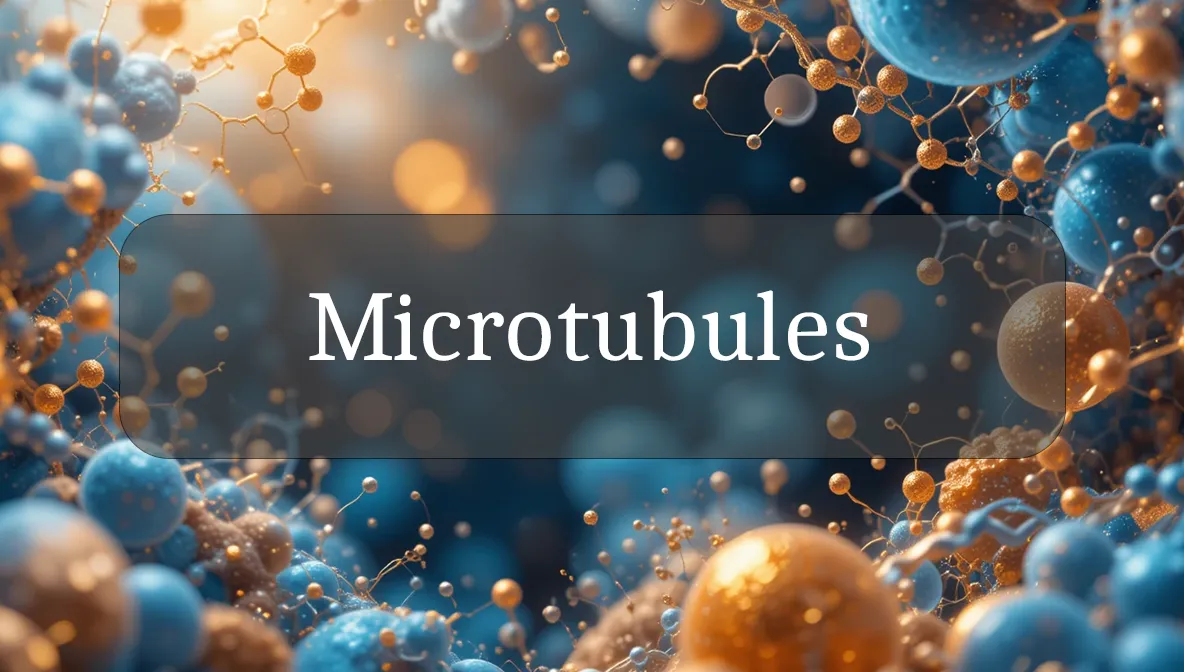Cellular Highways Powering Your Body’s Vitality
Microtubules are like the superhighways inside your cells, guiding the transport of nutrients, supporting cell division, and keeping your tissues strong and flexible. These tiny, tube-like structures form a dynamic network that ensures your cells function smoothly, from helping your nerves communicate to enabling your muscles to grow. For health-conscious folks eager to optimize their wellness, understanding microtubules can unlock insights into how your cells stay organized and energized. Let’s dive into what microtubules are, why they’re essential for your health, and how to support their role for a thriving you.
Identity and Function
Microtubules are hollow, tube-shaped cellular structures, part of the cytoskeleton, the cell’s internal scaffolding. Made of proteins called tubulin (alpha and beta units), they’re about 25 nanometers wide, the thickest of the cytoskeleton’s fibers. Found in the cytoplasm (cell’s fluid), microtubules act like tracks for transporting materials, beams for maintaining cell shape, and spindles for dividing cells. They’re constantly building and breaking down, adapting to the cell’s needs, making them vital for movement, division, and stability [1].
Biological Role and Health Impact
Microtubules are the workhorses of your cells, with a massive impact on your health:
- Cellular Transport: They guide motor proteins (like kinesin and dynein) to shuttle nutrients, organelles, or signals, keeping cells fueled and responsive [2].
- Cell Division: Microtubules form the mitotic spindle, ensuring chromosomes split evenly during cell division for growth, repair, or immune responses [1].
- Structural Support: They give cells shape and strength, supporting tissues like nerves, muscles, and skin [3].
- Nerve Function: In neurons, microtubules help transport signals, supporting memory, movement, and coordination [4].
- Health Implications: Faulty microtubules are linked to diseases like Alzheimer’s (where tangled networks disrupt brain signals) or cancer (where rapid division goes unchecked) [5].
Healthy microtubules keep your cells organized, your body repairing, and your mind sharp.
Supporting Health
Microtubules are produced by your cells, not consumed, but you can nurture their environment to keep them thriving:
- Balanced Diet: Proteins (e.g., eggs, fish) provide amino acids for tubulin, while folate supports cell division [2].
- Hydration: Water keeps cells fluid, aiding microtubule assembly and transport [3].
- Sleep and Recovery: Adequate rest (7–8 hours nightly) allows cells to rebuild microtubules, especially during repair or growth [4].
- Exercise: Regular activity (e.g., cardio or yoga) boosts cell health, supporting microtubule function in muscles and nerves [1].
Signs of Dysfunction
Microtubule problems are rare but can disrupt health:
- Dysfunction Signs:
- Fatigue or slow healing (from impaired cell division or repair) [2].
- Memory issues or coordination problems (e.g., in neurodegenerative diseases like Alzheimer’s) [4].
- Muscle weakness or numbness (from disrupted nerve transport) [3].
- Causes: Genetic mutations, severe nutrient deficiencies (e.g., protein or folate), or toxins like heavy metals can impair microtubules [5].
- Disease Link: Overactive microtubules in cancer cells fuel rapid division, while underactive ones may cause brain or nerve damage [4].
If you notice persistent neurological symptoms or slow recovery, consult a doctor, as these may signal deeper cellular issues.
Promoting Optimal Function
You can support your microtubules with practical, everyday habits:
- Eat Protein-Rich Foods: Aim for 0.8–1.2 g of protein per kg of body weight daily (e.g., salmon, beans) to supply amino acids for tubulin [1].
- Include Folate-Rich Foods: Leafy greens, avocados, or fortified cereals provide folate to support cell division and microtubule spindles [2].
- Boost Antioxidants: Berries, nuts, and bell peppers offer cell protectors to shield microtubules from stress or toxin damage [3].
- Stay Active: Engage in exercise like brisk walking, cycling, or weightlifting (150 minutes weekly) to stimulate cell repair and nerve function, keeping microtubules active [4].
- Limit Toxins: Avoid heavy metals (e.g., lead in old pipes) or excessive alcohol, which can disrupt microtubule networks—use filtered water if needed [5].
- Prioritize Sleep: Get 7–8 hours of rest to allow cells to rebuild microtubules, supporting brain and tissue repair [2].
No specific intake exists for microtubules, as your cells produce them based on demand, but a nutrient-rich lifestyle keeps them efficient.
Safety and Stressors
Microtubules are safe as natural cell components, but certain factors can stress them:
- Stressors:
- Nutrient Deficiencies: Lack of protein, folate, or magnesium can impair microtubule assembly, slowing cell function [3].
- Toxins: Heavy metals (e.g., mercury) or drugs like colchicine (used in gout treatment) can disrupt microtubules, harming cell division or transport [5].
- Chronic Stress: High stress or poor sleep can hinder cell repair, affecting microtubule dynamics [4].
- Safety Considerations:
- Genetic Conditions: Rare disorders like tubulinopathies (affecting tubulin proteins) require medical care, not dietary fixes [3].
- Environmental Toxins: Test well water for heavy metals and avoid harsh chemicals to protect cellular health [5].
- Medications: Some chemotherapy drugs (e.g., paclitaxel) target microtubules to stop cancer growth but may cause side effects like numbness [4].
- Who’s at Risk? Those with poor diets, genetic conditions, or toxin exposure may face higher risks of microtubule issues.
Fun Fact
Microtubules are like cellular roller coasters! Their tracks zoom motor proteins around the cell at speeds up to 2 micrometers per second, delivering cargo faster than a sprinter runs [1]!
Citations
- Alberts, B., et al. (2014). Molecular Biology of the Cell. Garland Science.
- National Library of Medicine. (2022). Cytoskeleton and Cellular Transport.
- Mayo Clinic. (2024). Nutrition and Cellular Health.
- National Institute of Neurological Disorders and Stroke. (2023). Neurodegenerative Diseases and Cytoskeleton.
- Centers for Disease Control and Prevention (CDC). (2023). Environmental Toxins and Cellular Health.

